Balancing multiple KPIs effectively can be challenging for advertisers when using traditional demand-side platforms (DSPs).
Fortunately, programmable split technology allows advertisers to execute complex strategies in Xandr while leveraging machine learning to hit secondary and tertiary KPIs.
KORTX’s Split Assist™ technology can optimize multiple splits in one day based on a single campaign metric. It also ensures that campaigns bid on the best-performing audiences and inventory first, leading to improved KPIs and better campaign outcomes.
Let’s review how programmable splits work, how Split Assist™ enhances its effectiveness, and how we at KORTX utilize splits to optimize campaigns and maximize marketing budgets.
Breaking It Down: How Programmable Splits Work
Split Assist™ is built on programmable splits. Within a line item, advertisers can create specific instructions for the DSP to execute a particular ad buy, and programmable splits take this a step further by allowing advertisers to divide a line item’s inventory into smaller subsets that allow you to:
- Target a specific subset of ad inventory that meet the criteria outlined in the line item.
- Adjust bids in real-time based on targeting to ensure optimal performance.
- Distribute the budget of a line item across selected targets to maximize ROI.
- Deliver various ad creative types to specific ad inventory subsets to enhance audience engagement and relevance.
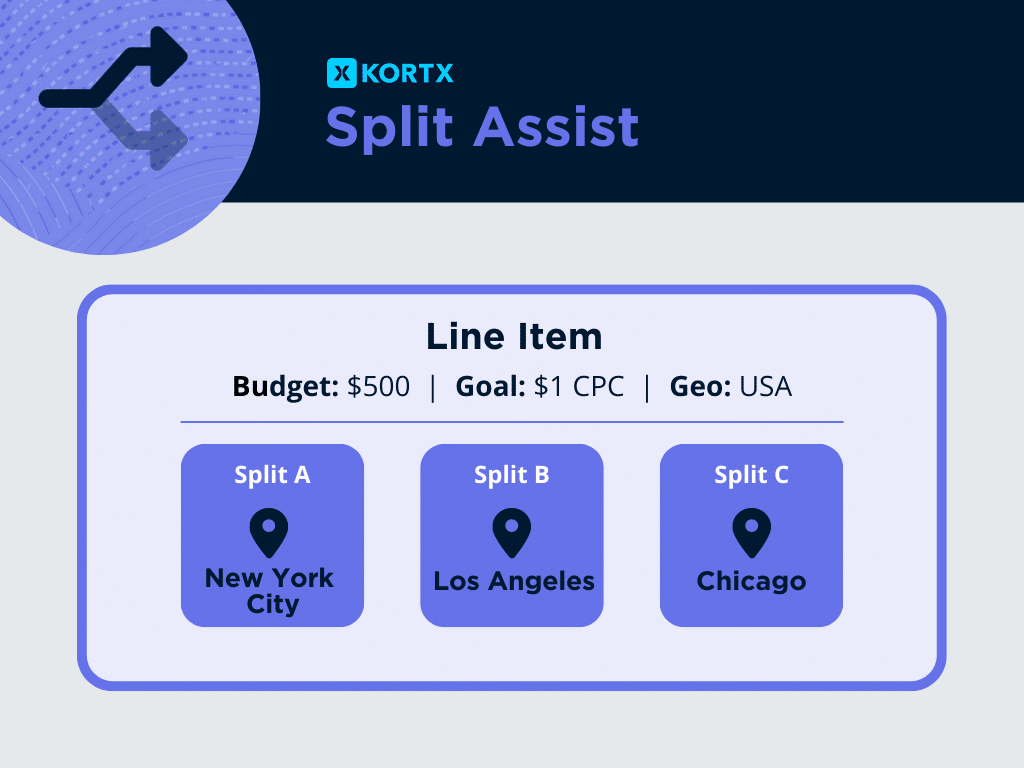
Think of a line item as a sieve that filters out the impressions that don’t match the specific targeting criteria the advertiser sets. Once the impressions pass through the sieve and match the targeting criteria, they get divided into smaller subsets called “splits,” each assigned unique targeting, budgets, and creative allocation, allowing advertisers to refine their targeting further and optimize their campaigns.
Advertisers can define splits by:
- Geography: Country, Region, City, Metro Code, etc.
- Inventory: Size, Domain or App, Placement, Publisher, etc.
- System: Operating System Family and/or Version, Browser, Device Type, etc.
- Inventory Performance: Viewability Threshold, Completion Rate Threshold, etc.
- Segment: Segment Age, Segment Value, etc.
- Frequency and Recency: Daily Frequency, Lifetime Frequency, Split Recency
💡 How you can use programmable splits in advertising
- Adjust KPIs manually (for instance, assign conversions to an external server)
- Monitor and control secondary KPIs (like allocating 20% of the budget to a specific geographic area if the delivery and performance targets of a line item are met)
- Utilize dynamic creative decision-making
- Prioritize spend towards a particular seller or publisher to meet business objectives
Source: Understanding Splits
Splits enable our Ad Operations team to further refine a line item’s targeting strategy by dividing the delivery of a campaign into 33 different targeting conditions through a prioritized waterfall.
We created over 600 targeting segments for a Financial Services client’s display, CTV, traditional video, and audio ads, using factors such as location, viewability, audience, device type, and daily frequency under one insertion order. This allowed our client to thoroughly analyze campaign data and extract valuable insights per brand location.
Split Assist™ is built on programmable splits.
What is KORTX’s Split Assist™️?
Split Assist™️ enables the KORTX Ad Ops team to guarantee daily optimizations by reprioritizing audience targeting according to the KPI. Whether conversion or CTR-based KPIs, Split Assist™️ provides consistent algorithmic adjustments based on audience outcomes.
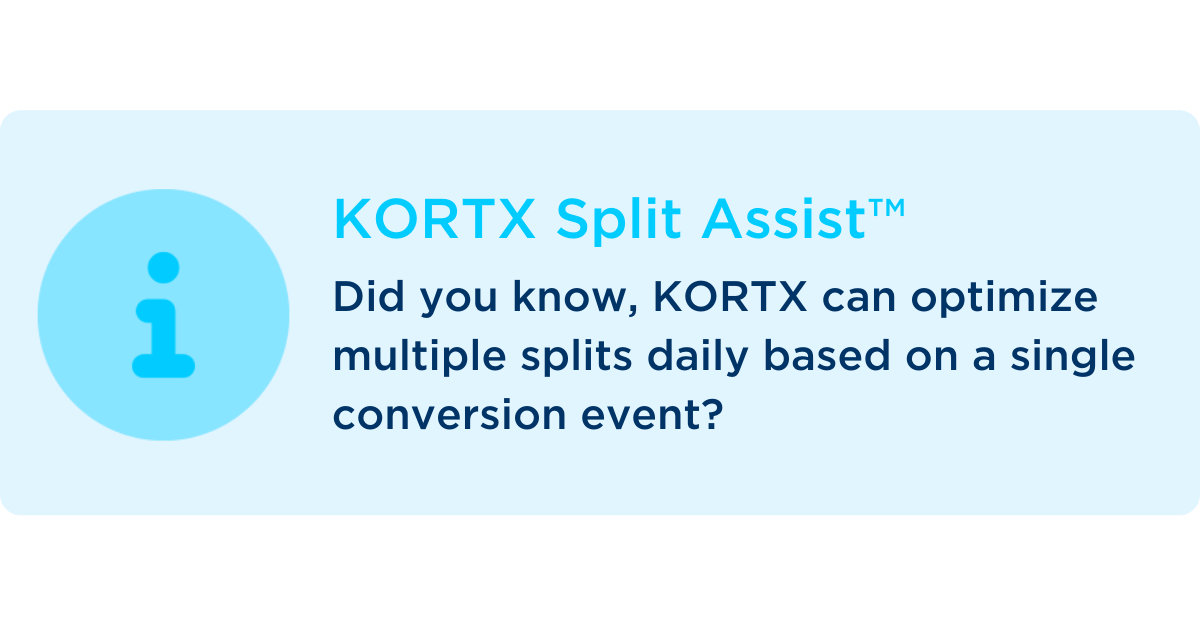
Split Assist™️ can work across all tactics within Xandr’s inventory library (e.g., CTV, display, etc), excluding digital-out-of-home, and social media platforms, and allows for micro-targeting without budget minimums.

An example of how using one audience segment per split lets us use the Split filter in Analytics reporting.
Since programmable splits work as a waterfall, with bid requests coming in for Split 1 and moving down as scaling requires, the campaign always bids on the best-performing audiences and inventory first.
Every day, the line item will analyze each split and compare their performance to a specific goal, such as a target cost per action (CPA), click-through rate (CTR), or total conversions.
Example: For CPA goals, the splits will re-prioritize based on the lowest CPA, thus guaranteeing daily optimizations and the best-performing segments filtered through the bid request first for every single impression available to bid on.
In a 90-day campaign, there will be 89 automatic optimizations prior to any manual human optimization effort.
Our Expert Team, Your Success.
Partner with KORTX to make the most out of your digital advertising budget.
✅ Creating unique target audiences through First- and Third-Party data integrations with our very own Axon Audience Manager.
✅ Drive local and online sales with our expert media strategy, targeting, monitoring, and reporting.
How We Use KORTX Split Assist™️ In Our Campaigns
At KORTX, we combine human and algorithmic optimization to ensure each campaign is executed to its fullest potential. To achieve this, we assign a dedicated Ad Operations Specialist to each KORTX campaign to analyze trends and optimize the campaign consistently.

We complement our specialist’s work with machine learning algorithms that execute a custom bidding strategy for each campaign.
Machine Learning: We start by analyzing relevant historical data for the advertiser and campaign parameters. Our programmable bidder presents trends or learnings from previous programs to the ops specialist during campaign construction to increase overall efficiency and output.
KORTX Split Assist™: After launching the campaign, our Split Assist™ tool automatically performs a nightly analysis performed against the splits, with the best-performing splits reprioritized based on performance.
📚 Related article: Interested in learning more about our Ad Ops specialists? Check out our article about Senior Ad Operations Specialist Bryan Presti’s day in the life at KORTX.
Let’s take a look at how we use splits for campaign construction and optimization.
Single-Audience Splits for Optimization
In these examples, all the campaigns have single audience splits, which Split Assist™️ optimizes daily based on conversion performance, resulting in more efficient use of the campaign budget by focusing on the best-performing combinations.
Education Client
We set up an Education Client with 22 prospecting splits organized by region, state, city, deals, and audiences.

Restaurant Client
The prospecting setup for a Restaurant Client was simpler, with only one condition focused on the audiences.
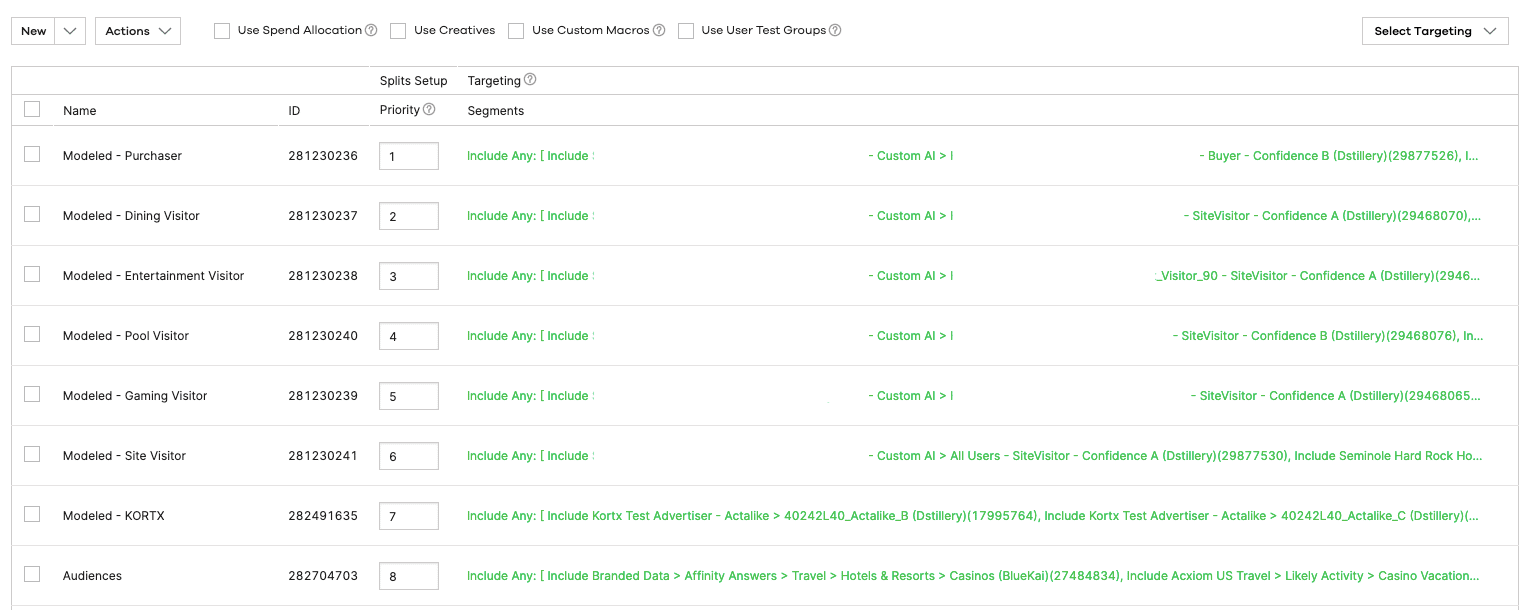
We set up a retargeting strategy for the same Restaurant Client campaign using a single Axon segment spread across 5 splits. Each split is prioritized based on conversion outcomes every night.
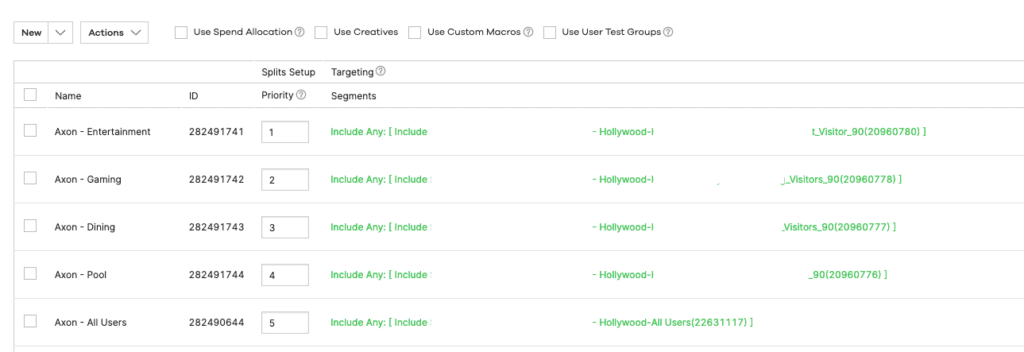
Tourism Client
In this setup for a Tourism Client, we constructed the programmable splits based on the client’s desired audience segmentation. This setup provides transparency into campaign performance and allows for daily optimizations based on website activity.
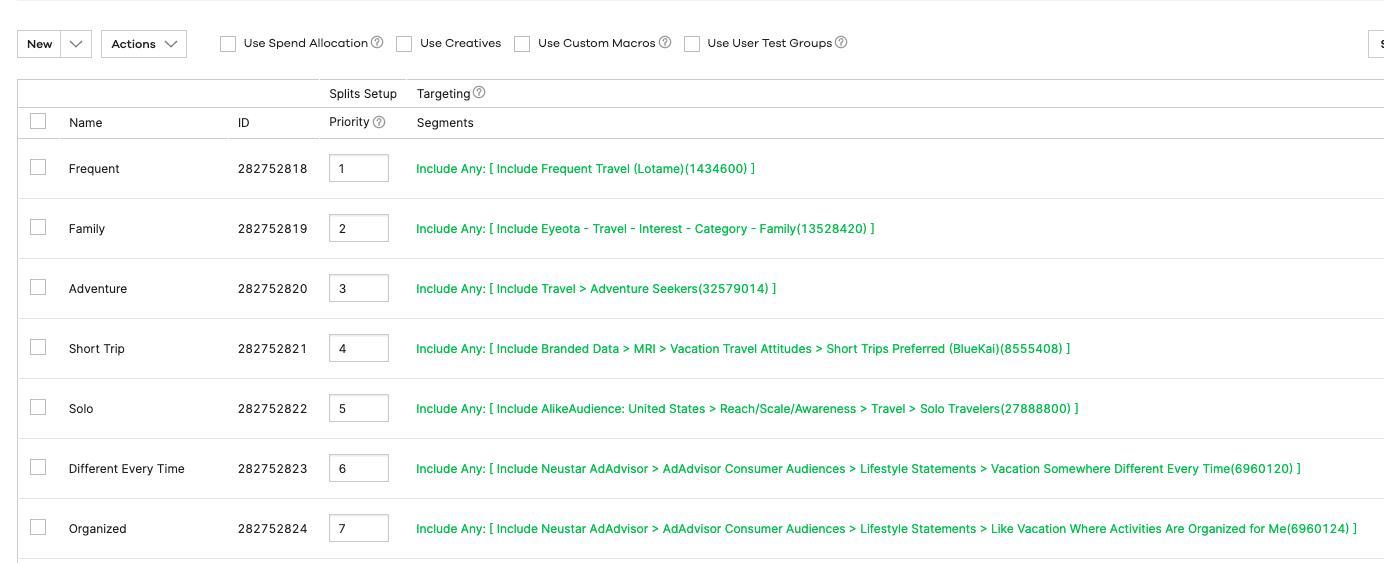
These splits allow Ad Ops to quickly analyze campaign outcomes by reviewing the splits at the bottom (those receiving the worst outcomes) to determine whether to turn them off.
Let’s look at another example of how we use Split Assist™ as a part of an overall campaign strategy.
An Advanced CTV Strategy + Split Assist™
In one connected TV (CTV) campaign, Split Assist™ allowed it to run on a single line item while isolating curated deals packaged by: News, Weather, Entertainment, Travel, Food + Drink, Sports, Lifestyle, Business, Tech + Auto + SciFi.
The Split
With 1,032 premium video inventory deals, we applied 9 deal lists to the line item as their own tactic, represented by a single split.
Then, we duplicated these 9 splits 5x to increase our targeting conditions and provide granular delivery transparency.
These 45 conditions include variations across segments, device type, and deals. To expand scale as much as possible on these CTV channels, our QSR client sought to include traditional devices (e.g., phones, tablets, and desktops) and standard CTV devices (e.g., set-top boxes, game consoles, and televisions).
KORTX Campaign Advantage + Split Assist: A Winning Combination
Ditch the traditional constraints! No more inflexible budgets and line items. Test and perfect your campaign strategies all within one budget!
To prioritize the brand’s content on large screens, our team analyzed delivery by split and adjusted the setup for a higher percentage of impressions on those in-home screens (which usually have the largest audience).
Additionally, QSR client First-Party Axon audience segments utilize the split bid modifier capability, increasing bid ranges on audiences with a historical 16:1 ROAS for display. Those QSR client First-Party segments are also the building blocks for our new customer efforts, maintaining a 2:1 display prospecting ROAS through modeling those numerous segments.
Incorporating Split Assist™
CTV campaigns require a hands-on approach due to the lack of optimization algorithms for CTV inventory and a campaign’s limited ability to input a CPA goal against a single conversion event on the website.
Our goal for the campaign was to target the most effective audiences from other digital mediums: First-Party audiences for re-engagement and as seed sets for look-alike prospecting efforts. We aimed for 100% delivery to these audiences on CTV, which would drive site activity and purchases, showcasing the campaign’s value for the QSR client.
Our KORTX engineers worked with the media buying team and used KORTX Split Assist™ to create the 45 splits based on a single conversion event on the QSR client website.
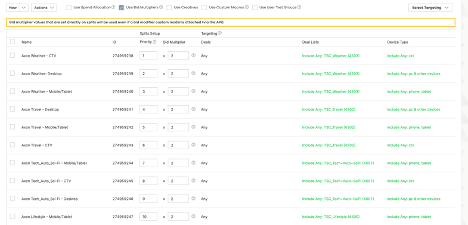
Daily, Split Assist™ analyzes all 45 splits and prioritizes them based on the cost per acquisition (CPA) of a homepage pixel fire, ranking splits from 1-45 based on their CPA.
The Results
KORTX Split Assist™ contributed to a $1.69 CPA for March, decreasing by half month over month, and purchases attributed to CTV doubled in the second half of Q1.
Split Assist™: An Innovative Approach to Split Optimization
Programmable split technology has transformed the way advertisers approach digital campaigns. This technology allows advertisers to optimize multiple KPIs using machine learning and execute complex strategies that were previously impossible.
KORTX’s proprietary Split Assist™ technology ensures that campaigns bid on the best-performing audiences and inventory first, improving KPIs and better campaign outcomes.
Split Assist™ optimizes campaigns by dividing them into smaller groups based on important factors or variables, allowing each group to be analyzed separately and independently. We can achieve better outcomes, save time, and maximize marketing budgets.
Maximize Your Campaign Potential with KORTX
At KORTX, we combine human and algorithmic optimization to ensure each campaign is executed to its fullest potential.
Bryan Presti is the Head of Programmatic Trading at KORTX.
